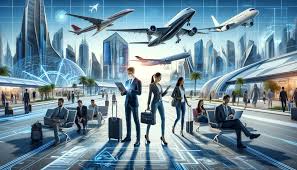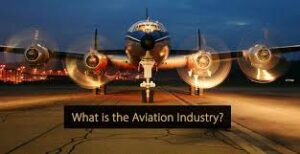Overview of the Aviation Industry 
The aviation industry is one of the most vital sectors of the global economy, serving as the backbone of international trade, tourism, and economic connectivity. It plays a critical role in facilitating the movement of goods, people, and ideas across the globe, connecting distant corners of the world, and fostering international cooperation. In this overview, we will explore the different facets of the aviation industry, from its historical development to its current state, key components, challenges, and the future of aviation.
- The Evolution of the Aviation Industry
The aviation industry has a rich history that spans over a century. It began with the first powered flight in 1903, when the Wright brothers, Orville and Wilbur Wright, successfully flew the first motorized airplane at Kitty Hawk, North Carolina. However, it wasn’t until the early 20th century that aviation began to have a significant impact on commerce and travel.
In the 1910s and 1920s, aviation became increasingly important for both military and commercial purposes. The growth of commercial air travel was spurred by post-World War I technological advances, such as the development of larger and more reliable airplanes. By the 1930s and 1940s, air travel had become an essential part of the global transport infrastructure, with airlines like Pan American Airways and Trans World Airlines (TWA) pioneering long-haul international flights.
The growth of the aviation industry surged after World War II, as aircraft technology improved, commercial jets became available, and the postwar economic boom increased demand for travel. The introduction of the Boeing 707 in 1958 marked the beginning of the Jet Age, making air travel faster, more affordable, and more accessible to a broader public.
Since the 1970s, the aviation industry has undergone further advancements, such as the development of wide-body jets (e.g., the Boeing 747) and the shift toward hub-and-spoke models in airline operations. The 21st century has brought with it the growth of low-cost carriers, increased competition, and a focus on sustainability, safety, and new technology.
- Key Components of the Aviation Industry
The aviation industry is a highly complex system that includes a wide array of components. Below, we outline some of the most important segments of the aviation industry:
- Commercial Aviation
Commercial aviation refers to the operation of aircraft for the purpose of carrying passengers and cargo. This sector includes both scheduled airlines (e.g., American Airlines, Lufthansa, Emirates) and charter airlines (e.g., private or special interest carriers). Commercial aviation is typically divided into two categories:
- Full-service carriers (FSCs): These airlines offer comprehensive services, including multiple cabin classes (economy, business, first class), meals, entertainment, and extensive route networks. Examples include Singapore Airlines and British Airways.
- Low-cost carriers (LCCs): Airlines that offer lower fares by eliminating many amenities and services, such as in-flight meals and entertainment. They typically operate on point-to-point routes and focus on efficiency and cost-cutting. Examples include Southwest Airlines, Ryanair, and easyJet.
- Air Cargo and Freight
Air cargo refers to the transportation of goods and commodities via air. This segment of the aviation industry includes dedicated cargo airlines (such as FedEx, DHL, and UPS) and integrated services provided by commercial airlines through their cargo divisions (e.g., Lufthansa Cargo and Emirates SkyCargo). Air freight is critical for the rapid delivery of high-value and perishable goods, including electronics, pharmaceuticals, and fresh produce.
The growth of global trade and e-commerce has made air cargo an increasingly important sector within the aviation industry, and the rise of express shipping services has spurred demand for fast, reliable air transport.
- Aircraft Manufacturing

Aircraft manufacturing is the backbone of the aviation industry. Two primary manufacturers dominate the global aircraft industry: Boeing (USA) and Airbus (Europe). These companies design and produce a wide range of commercial, military, and private aircraft. Additionally, smaller manufacturers like Embraer (Brazil) and Bombardier (Canada) contribute to the production of regional and smaller aircraft.
Aircraft manufacturing is a highly specialized and capital-intensive field, requiring years of development, extensive testing, and certifications from regulatory bodies like the Federal Aviation Administration (FAA) and the European Union Aviation Safety Agency (EASA). Advances in materials science, aerodynamics, and engine technology continue to shape the future of aviation.
- Airports and Ground Services
Airports are integral hubs in the aviation system, serving as points of departure, arrival, and layover for passengers and cargo. Modern airports are complex facilities that provide various services, including check-in counters, security screenings, lounges, baggage handling, and refueling. They also include commercial facilities, such as restaurants, duty-free shops, and entertainment options for passengers.
There are three categories of airports:
- Hub airports: These are large airports that serve as central points for connecting flights, often for major international carriers (e.g., London Heathrow, Dubai International, and Chicago O’Hare).
- Regional airports: Smaller airports that primarily serve domestic flights or short-haul routes (e.g., Cleveland Hopkins International).
- Private airports: Airports that cater to private and charter flights, often serving smaller planes and business jets.
In addition to airport operators, there are numerous ground services companies that manage operations on the tarmac, including aircraft maintenance, cargo handling, refueling, and catering.
- Air Traffic Control (ATC)

Air traffic control is a critical component of the aviation industry that ensures the safe and efficient flow of air traffic. ATC services guide aircraft during takeoff, flight, and landing to prevent collisions and ensure proper sequencing of flights. These services are provided by governmental agencies (e.g., the FAA in the United States, Eurocontrol in Europe, and Nav Canada in Canada) or private contractors.
ATC systems have evolved with advances in technology, from radar-based systems to more sophisticated satellite-based navigation systems (e.g., ADS-B—Automatic Dependent Surveillance-Broadcast), which improve situational awareness and communication between pilots and air traffic controllers.
- Economic Impact of the Aviation Industry
The aviation industry has a significant impact on the global economy. According to the Air Transport Action Group (ATAG), aviation supports over 65 million jobs worldwide, ranging from pilots and flight attendants to engineers, air traffic controllers, and ground crew. In terms of economic output, the aviation industry contributes trillions of dollars to global GDP each year, accounting for approximately 3.6% of global GDP.
In addition to direct employment, aviation stimulates job creation in related sectors, such as tourism, trade, logistics, and hospitality. For example, international tourism is heavily reliant on air transport, and many countries rely on aviation to drive their tourism industries. The aviation sector is also crucial for global trade, with air cargo enabling the movement of high-value, time-sensitive goods that would not be viable via sea or land transport.
- Challenges Facing the Aviation Industry
While the aviation industry has grown substantially, it faces several challenges that can affect its future development:
- Environmental Concerns
One of the most pressing challenges facing the aviation industry is its impact on the environment. Aircraft are major contributors to carbon emissions, and the growing number of flights increases the aviation industry’s carbon footprint. The aviation sector accounts for approximately 2-3% of global CO2 emissions, and while aviation emissions are growing at a faster rate than other sectors, efforts are underway to mitigate this.
Technological innovations, such as the development of electric and hybrid-electric aircraft, sustainable aviation fuels (SAF), and improved aerodynamics, are helping reduce emissions. However, achieving significant reductions in aviation’s environmental impact will require substantial investments and regulatory changes, such as international carbon offset programs and green airports.
- Security Concerns

The aviation industry has been a target for terrorism and hijacking, with events such as the 9/11 attacks in 2001 serving as tragic reminders of the vulnerabilities of the aviation system. As a result, security has become a top priority for governments, airlines, and airports. The increased cost and complexity of security procedures, from airport screening to air marshal programs, add operational challenges for airlines and passengers alike.
Emerging threats, including cyberattacks on aviation systems and the potential for drones to interfere with aircraft, present new security risks that the industry must address.
- Economic Instability and Pandemic Impact
The aviation industry is highly sensitive to economic cycles and global crises. The 2008 financial crisis and the COVID-19 pandemic caused significant disruptions in air travel, leading to widespread flight cancellations, financial losses for airlines, and long-term industry recovery. The COVID-19 pandemic, in particular, led to a sharp decline in air travel, with a 60% reduction in global passenger traffic in 2020, and many airlines were forced to seek government bailouts or file for bankruptcy.
As the world emerges from the pandemic, the aviation industry is slowly recovering, but ongoing economic instability, rising fuel costs, and geopolitical tensions (e.g., the Russia-Ukraine conflict) continue to pose risks to the sector’s financial stability.
- The Future of Aviation
Looking ahead, the aviation industry is poised for several transformations that will shape the future of air travel:
- Sustainability: With a growing emphasis on reducing carbon emissions, the aviation industry is investing heavily in sustainable technologies, including electric aircraft, sustainable aviation fuel (SAF), and innovations in air traffic management to optimize flight routes and reduce fuel consumption.
- Automation and AI: Automation technologies, including autonomous aircraft and AI-powered air traffic control, have the potential to improve safety, efficiency, and reduce costs. Airlines are also adopting AI to enhance customer service, from personalized in-flight experiences to automated check-ins.
- Urban Air Mobility: The development of eVTOL (electric vertical takeoff and landing) aircraft presents the possibility of urban air transport, with flying cars or small drones offering solutions for short-distance travel in cities and metropolitan areas.
- Hyperloop and Supersonic Travel: Future transportation alternatives, such as hyperloop (a high-speed ground-based transportation system) and the resurgence of supersonic air travel, could further transform the way people travel, reducing journey times significantly.
Conclusion
The aviation industry is a dynamic, multifaceted sector that has transformed the way the world connects, enabling globalization and the efficient movement of people and goods. While the industry has faced numerous challenges, it has shown remarkable resilience and adaptability. Moving forward, technological innovation, environmental sustainability, and security will be central to the ongoing evolution of the industry. As air travel continues to expand, the aviation sector will play a key role in shaping the future of global connectivity
